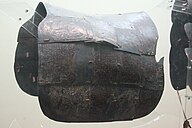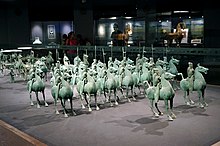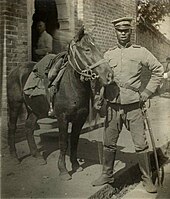Horses in ancient and Imperial China were an important element in Chinese society on cultural, military, and agricultural levels. Horses were introduced from the West, disrupting methods of warfare, and forcing local warring states to adopt new military practices such as chariots (c. 1000 BC) and cavalry. The strategic role of horses in large numbers for military defense against steppe invaders is well documented. The furthest Chinese conquests to the north and west were achieved under the Han, Tang, Ming and Qing dynasties thanks to extensive military-managed horse-farms, involving hundreds of thousands of horses. Horses were highly valued and prevalent until late in Qing dynasty period of 1644–1912. Increased industrialization, increased use of mechanical labor, and China's century of humiliation (c. 1840 – c. 1950) led to the virtual disappearance of China's equine tradition.
Ancient China

 Lacquered horse armor excavated from the Tomb of Marquis Yi of Zeng, Eastern Zhou dynasty, China
Lacquered horse armor excavated from the Tomb of Marquis Yi of Zeng, Eastern Zhou dynasty, China




There were horse-driven chariots of the Shang (c. 1600 – c. 1050 BC) and Zhou (c. 1050 – c. 256 BC) periods, but horseback riding in China, according to David Andrew Graff, was not seen in warfare prior to the 4th century BC.
King Wuling of Zhao (340–295 BC), after realizing the advantages of light cavalry warfare over that of the heavy and cumbersome chariots, instituted reforms generally known as "胡服骑射" (wearing of the Hu-nomadic people's attire, and shooting arrows from horseback), which greatly increased the combat-effectiveness of the army of Zhao.
Although mounted archers represented an initial tactical advantage over Chinese armies, the Chinese learned to adapt. Conservative forces opposed change, which affected the proportional balance amongst cavalrymen, horse-drawn chariots and infantrymen in Chinese armies.
The benefits of using horses as light cavalry against chariots in warfare was understood when the Chinese confronted incursions from nomadic tribes of the steppes.
The Chinese used chariots for horse-based warfare until light cavalry forces became common during the Warring States era (402–221 BC); and speedy cavalry accounted in part for the success of the Qin dynasty (221–206 BC).
Imperial China
Feeding horses was a significant problem, and many people were driven from their land so that the Imperial horses would have adequate pastures. Climate and fodder south of the Yangtze River were unfit for horses raised on the grasslands of the western steppes. The Chinese army lacked a sufficient number of good quality horses. Importation was the only remedy but the only potential suppliers were the steppe-nomads. The strategic factor considered most essential in warfare was controlled exclusively by the merchant-traders of the most likely enemies.
The Chinese warhorses were cultivated from the vast herds roaming free on the grassy plains of northeastern China and the Mongolian plateau. The hardy Central Asian horses were generally short-legged with barrel chests. Speed was not anticipated from this configuration, but strength and endurance are characteristic features.
Han dynasty
During the Han dynasty (206 BC – 220 AD), records tell of a Chinese expedition to Fergana (in present-day Uzbekistan) and the superior horses which were acquired. The horses were acquired for military use and for breeding.
- "Horses are the foundation of military power, the great resources of the state but, should this falter, the state will fall"
- -- Ma Yuan (14 BC – 49 AD), a Han general and horse expert.
- "Horses are the foundation of military power, the great resources of the state but, should this falter, the state will fall"
During the Jin dynasty (266–420), records of thousands of "armored horses" illustrate the development of warfare in this period.
Tang dynasty

Horses and skilled horsemen were often in short supply in agrarian China, and cavalry were a distinct minority in most Sui dynasty (581–618) and Tang dynasty (618–907) armies. The Imperial herds numbered 325,700 horses in 794.
Song dynasty
The Song (960–1279) through Ming dynasty (1368–1644) armies relied on an officially supervised tea-for-horse trading systems which evolved over centuries.
Tea and horses were so inextricably related that officials repeatedly requested that the tea laws and the horse administration be supervised by the same man. From the perspective of the Chinese court, government control of tea was the first step in the creation of a rational and effective policy aimed at improving the quality of horses in the army.
Ming dynasty
In the late Ming dynasty, the marked inferiority of the Chinese horses was noted by the Jesuit missionary and ambassador Matteo Ricci (1552–1610), who observed:
- " have countless horses in the service of the army, but these are so degenerate and lacking in martial spirit that they are put to rout even by the neighing of the Tartars steed and so they are practically useless in battle."
Qing dynasty

| This section is empty. You can help by adding to it. (November 2023) |
See also
- Domestication of the horse
- Horses in Chinese culture
- Horse in Chinese mythology
- Horses in East Asian warfare
- History of the horse in the Indian subcontinent
Sources
- Wan, Xiang (2013-01-01). The Horse in Pre-Imperial China (Thesis). University of Pennsylvania.
- Cooke, Bill, ed. (2000). Imperial China: the art of the horse in Chinese history ; exhibition catalog (First ed.). Lexington, KY: Kentucky Horse Park / Art Media Resources Ltd. ISBN 978-1-56469-071-5.
- Sterckx, Roel; Siebert, Martina; Schäfer, Dagmar, eds. (2018). Animals through Chinese History: Earliest Times to 1911. Cambridge: Cambridge University Press. ISBN 978-1-108-42815-6.
- Morgan, Carole (1974). "Dogs and Horses in Ancient China". Journal of the Hong Kong Branch of the Royal Asiatic Society. 14: 58–67. ISSN 0085-5774.
- Schottenhammer, Angela (2009). "Horses in Late Imperial China and Maritime East Asia:". Pferde in Asien: Geschichte, Handel und Kultur: 229.
References
- Creel, H. G. (1965). "The Role of the Horse in Chinese History". The American Historical Review. 70 (3): 647–672. doi:10.2307/1845936. ISSN 0002-8762.
-
Honeychurch, William (5 November 2014). "At the Edge of Inner Asia: The Northern Zone and States of China, 1200-700 BC". Inner Asia and the Spatial Politics of Empire: Archaeology, Mobility, and Culture Contact. New York: Springer. p. 194. ISBN 9781493918157. Retrieved 27 May 2024.
there does not seem to be any indisputable material evidence for chariots from the eastern part of the Northern Zone until the very end of the second or the beginning of the first millennium BC. chariots probably gained privileged status among the Shang prior to their introduction to politically important regions further east and northeast . In China this steppe technology was newly arrived and poised to have a major impact on politics, warfare, and the practice of statecraft in East Asia.
- ^ Graff, David Andrew. (2002). Medieval Chinese Warfare, 300-900, p. 22., p. 22, at Google Books
- "LINE Dictionary : English-Thai, Chinese-English, English-Chinese Dictionary". nciku.com.
- Graff, p. 28., p. 28, at Google Books
- Ellis, John. (2004). Cavalry: The History of Mounted Warfare, pp. 19–20.
- Goodrich, p. 99., p. 99, at Google Books
- Goodrich, p. 100., p. 100, at Google Books
- ^ Sinor, Denis. "Horse and Pasture in Inner Asian history," Oriens Extremus, Vol. 19, No. 1–2 (1972), pp. 171–183.
- Gilbey, Walter. (1900). Small Horses in Warfare. p. 26., p. 26, at Google Books
- AMNH: "The Origin of Horses."
- ^ "The importance of the horse in Chinese art". churchviewantiques.com. Archived from the original on 12 March 2008.
- Graff, p. 42., p. 42, at Google Books
- Graff, p. 176., p. 176, at Google Books
- Graff, p. 228., p. 228, at Google Books
- Perdue, Peter. (2005). China Marches West, pp. 36–52., p. 36, at Google Books
| Horses | |
|---|---|
| Equine science and management | |
| Equestrianism and sport | |
| History | |
| Warfare | |
| Horse breeds and types | |
| Culture | |